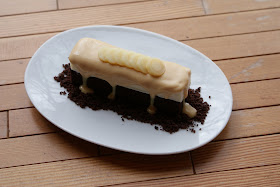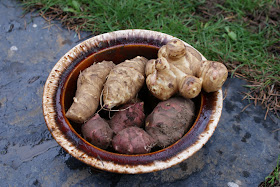Last week, I was asked to give a lecture at Young's Columbia on food pairings with sake. One of the topics that I discussed was the presence of umami in sake. This portion of the lecture evoked the most interest, and I was surprised that even among professionals, this term may be recognized but little understood. I decided to describe umami and try to clarify some of its elusive magic.
The Primary Flavors
There are five primary flavor profiles of taste. Two of them are metabolic, salty and sweet. We need these compounds for our bodies to function. Two of them are protective, bitter and sour. These tastes were originally used to determine whether our food was safe to eat. Many bitter flavors in nature are toxic, and sour often indicates a high presence of bacteria. We've learned to overcome those primordial associations, and these flavors are now a part of a more sophisticated palate. The fifth taste has always existed, but we've only come to recognize it in recent years. This fifth taste became a buzz word in the media about ten years ago, but it is still poorly understood. It is called umami. This term was created from the Japanese words umai, meaning "delicious," and the suffix mi, meaning "to taste." So, this new flavor profile that we just identified after thousands of years of civilization is termed deliciousness! It seems incredible that we could have overlooked that as a primary flavor profile.
There is a reason for this long-standing oversight. This delicious flavor is not as simple as the other primary flavors. We know that an apple or a pear is going to be sweet, and we know that a lemon is going to be sour. This is obvious to us. Umami describes a flavor that we are genetically designed to crave. These flavor compounds are called glutamates, and they are the most abundant amino acids in nature. (Technically, glutamates are the salt compounds of glutamic acid, which is the root of umami. I am going to use the terms interchangeably.)
This compound is present in everything from tomatoes and cheese, to mushrooms and seaweed. Even a mother's milk is abundant in glutamates, which should give some indication of how deeply rooted our genetic disposition is. When our taste buds detect glutamates, an electric impulse goes straight into our brain, and our brain says, "This is delicious. You want to eat more of this." The reason for this is that these glutamates are rich in amino acids that are ready for our bodies to metabolize. They are ready to use, and they take less energy and facilitate more of our biological functions than other compounds.
Synergistic Effects, or Sodium and Salinity
Without getting too technical here, the strength of our disposition toward glutamates becomes even stronger in the presence of other compounds. Inosinates in proteins, and guanylates in cellulose make the effects of glutamic acids and succinic acids even more desirable flavors. This is where sake comes in. Sake has a special relationship with umami rich foods. These flavor compounds create a synergistic effect. We all know this when we grate cheese on our spaghetti with tomato sauce, or when we make miso soup with mushrooms. The reason sake resonates so well with food is that it has a link to umami flavors, which are the most abundant amino acids in nature.
Of course, tasting is always subjective. We all like what we like for different reasons. However, next time you are going to have some barbequed pork ribs, instead of just opening a bottle of pale ale, try a rich junmai instead. The next time you are going to have a bowl of spaghetti alla carbonara, before you open a bottle of chianti, try a good yamahai. When you want to shuck some oysters on the patio, before you chill your muscadet, chill a gingo instead.
Wine in particular has a much higher acidity and sodium level, which inhibits these synergistic effects. This is one of the reasons why you don't drink wine with caviar. It tastes too metallic and salty. Vodka is the traditional accompaniment for a good reason. It has no acidity or sodium. For the open minded oenophile, try a blind tasting, and let your tastebuds surprise you.

 The so-called Spanish black radish is especially tolerant of cold climates, and unlike most winter radishes, it stores well after harvesting. It has a very strong flavor reminiscent of horseradish, and often used in the same way. This root vegetable is common among eastern European cultures. It can be grated and mixed with sour cream or rendered goose fat to spread on dense pumpernickel or rye. It makes a good pickle, or braised until tender with cream or butter.
The so-called Spanish black radish is especially tolerant of cold climates, and unlike most winter radishes, it stores well after harvesting. It has a very strong flavor reminiscent of horseradish, and often used in the same way. This root vegetable is common among eastern European cultures. It can be grated and mixed with sour cream or rendered goose fat to spread on dense pumpernickel or rye. It makes a good pickle, or braised until tender with cream or butter. 




 The melting qualities of Gruyere are well known and deserved. It is made from unskimmed and unpasteurized cow's milk, with a fat content of 45%. Aged from eight to ten months in 75 pound wheels, the dense texture and cream content make it one of the perfect melting cheeses, with its fruity aroma and nutty characteristics opening up as it melts. Shaving the cheese on a wooden Swiss mandolin is certainly fun, but you can use whatever you have. The dish is reminiscent of the classic Swiss croute au fromage, which is a sort of open faced croque monsieur. I have added a few elements to the traditional bread, ham and cheese. At the base of the dish are caramelized onions braised in beer. On top of that is a piece of grilled bread covered with melted Gruyere slices. Then we saute some chanterelle mushrooms and toss them with fresh sliced ham, pickled pears and pickled mustard seeds. As with the original croute au fromage, this is a hearty cold weather dish.
The melting qualities of Gruyere are well known and deserved. It is made from unskimmed and unpasteurized cow's milk, with a fat content of 45%. Aged from eight to ten months in 75 pound wheels, the dense texture and cream content make it one of the perfect melting cheeses, with its fruity aroma and nutty characteristics opening up as it melts. Shaving the cheese on a wooden Swiss mandolin is certainly fun, but you can use whatever you have. The dish is reminiscent of the classic Swiss croute au fromage, which is a sort of open faced croque monsieur. I have added a few elements to the traditional bread, ham and cheese. At the base of the dish are caramelized onions braised in beer. On top of that is a piece of grilled bread covered with melted Gruyere slices. Then we saute some chanterelle mushrooms and toss them with fresh sliced ham, pickled pears and pickled mustard seeds. As with the original croute au fromage, this is a hearty cold weather dish.









































